Abstract
Objective:
To compare outcomes of appendectomy in an Acute Care Surgery (ACS) model to that of a traditional home-call attending surgeon model.
Summary Background Data:
Acute care surgery (ACS, a combination of trauma surgery, emergency surgery, and surgical critical care) has been proposed as a practice model for the future of general surgery. To date, there are few data regarding outcomes of surgical emergencies in the ACS model.
Methods:
Between September 1999 and August 2002, surgical emergencies were staffed at the faculty level by either an in-house trauma/emergency surgeon (ACS model) or a non-trauma general surgeon taking home call (traditional [TRAD] model). Coverage alternated monthly. Other aspects of hospital care, including resident complement, remained unchanged. We retrospectively reviewed key time intervals (emergency department [ED] presentation to surgical consultation; surgical consultation to operation [OR]; and ED presentation to OR) and outcomes (rupture rate, negative appendectomy rate, complication rate, and hospital length of stay [LOS]) for patients treated in the ACS and TRAD models. Questions of interest were examined using χ2 tests for discrete variables and independent sample t test for comparison of means.
Results:
During the study period, 294 appendectomies were performed. In-house ACS surgeons performed 167 procedures, and the home-call TRAD surgeons performed 127 procedures. No difference was found in the time from ED presentation to surgical consultation; however, the time interval from consultation to OR was significantly decreased in the ACS model (TRAD 7.6 hours vs. ACS 3.5 hours, P < 0.05). As a result, the total time from ED presentation to OR was significantly shorter in the ACS model (TRAD 14.0 hours vs. ACS 10.1 hour, P < 0.05). Rupture rates were decreased in the ACS model (TRAD 23.3% vs. ACS 12.3%, P < 0.05); negative appendectomy rates were similar. The complication rate in the ACS model was decreased (TRAD 17.4% vs. ACS 7.7%, P < 0.05), as was the hospital LOS (TRAD 3.5 days vs. ACS 2.3 days, P < 0.001).
Conclusions:
In patients with acute appendicitis, the presence of an in-house acute care surgeon significantly decreased the time to operation, rupture rate, complication rate, and hospital length of stay. The ACS model appears to improve outcomes of acute appendicitis compared with a TRAD home-call model. This study supports the efficacy and efficiency of the ACS model in the management of surgical emergencies.
Acute care surgery, a combination of trauma surgery, emergency surgery, and surgical critical care, has been proposed as a new specialty in general surgery. Several trauma and critical care programs around the country have described their experience with integrating emergency general surgery into their practice. This is the first study to compare outcomes for emergency surgical patients cared for in an acute care surgery model to that of patients cared for in a traditional home-call attending surgeon model.
The future of trauma surgery as a career has become a topic of much debate in academic circles. Many factors have likely contributed to the relative shortage of trauma critical care surgeons. One recurring theme noted by a number of authors is the decreasing operative exposure for surgeons caring for injured patients.1–3 The predominance of nonsurgical management in blunt trauma and the decreasing incidence of penetrating trauma have resulted in a decreased operative experience in recent years. At the same time, emergency care is at a crisis, with widespread problems of access, overcrowding, boarding, and delays.4,5 Marked increases in emergency department visits by older, sicker patients, many with surgical emergencies, are more common and require a continuous workforce of surgical specialists to respond, evaluate, operate, and deliver critical care. Unfortunately, emergency departments are having significant and greater difficulties assuring specialist coverage. One recent report documents that over two thirds of emergency department directors report shortages of on-call specialists at their hospitals.6
In response to these issues, many hospitals have had their trauma programs absorb emergency surgery into their practice.3,7 This model of acute care surgery (ACS), a combination of trauma surgery, broad-based emergency surgery, and surgical critical care, has been championed by the American Association for the Surgery of Trauma and a number of other trauma and surgical societies.2 A formal training curriculum is being developed, and plans for potential board certification are being explored. Several programs have reported their experience with the integration of emergency general surgery into their trauma programs.3,7–10 Most of these reports focus on surgeon satisfaction, surgeon caseload and diversity, and surgeon productivity. None, to date, has examined the effect of this integrated model on outcomes for patients with nontrauma surgical emergencies.
The purpose of this study is to compare outcomes of patients with acute appendicitis in an in-house ACS model to that of a traditional (TRAD) home call attending surgeon model.
METHODS
The Institutional Review Board of the University of Pennsylvania approved this study. The Hospital of the University of Pennsylvania is an urban, academic, level I trauma center. An integrated trauma and emergency surgery service evolved at our institution over several years. Prior to September 1999, the trauma service provided care only to patients with traumatic injuries. A separate general surgery service performed all emergency general surgery and unassigned elective general surgery. From 1999 to 2002, the trauma service participated in the evaluation and care of emergency general surgery patients on a monthly basis. Trauma surgeons participated in attending-level staffing of nontrauma and emergency general surgery for 4 months in academic year (AY) 1999–2000, 8 months in AY 2000–2001, and 12 months in AY 2001–2002. All other months were staffed by nontrauma general surgeons of various surgical subspecialties (gastrointestinal surgery, colorectal surgery, surgical oncology, etc). The trauma attending took 24-hour periods of in-house call. Nontrauma general surgeons took call from home. All other aspects of hospital care, including the resident complement, remained unchanged during this time. General surgery consults were initially evaluated by a PGY-3 in all cases, and reviewed with a senior resident (PGY-4 or PGY-5). The case was then discussed with an attending surgeon.
The Hospital of the University of Pennsylvania Perioperative Services database (Navigator: Navicare Systems, Inc.) was searched for CPT codes 44950 (open appendectomy), 44960 (appendectomy for ruptured appendix), and 44970 (laparoscopic appendectomy) between September 1999 and August 2002. Incidental appendectomies as part of another planned operative procedure were excluded. Patients admitted with appendiceal abscess and subsequently undergoing interval appendectomies were included in the study but were not included in calculations for time to the operating room (OR).
We retrospectively reviewed all charts identified through the above search and collected data regarding patient demographics, attending surgeon documentation, preoperative evaluation, and surgical intervention. Key time intervals were abstracted for each patient (Fig. 1). These included the interval from emergency department (ED) presentation to surgical consultation, the interval from surgical consultation to the OR, and the interval from ED presentation to the OR. Operative and pathology reports for all cases were reviewed. Outcomes measured included rupture rate, negative appendectomy rate, complication rate, and hospital length of stay. Complications included ileus, small bowel obstruction, wound infection, intraabdominal abscess, GI bleed, and urinary retention.
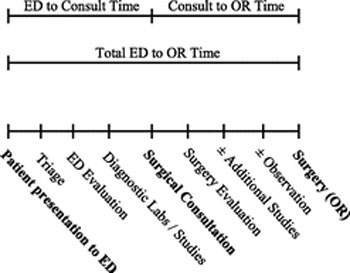
FIGURE 1. Timeline. Three time intervals were calculated for each patient: time from ED presentation until surgical consultation, time from surgical consultation until surgery, and total time from ED presentation until surgery. Process components that occurred during each time period are displayed. ED, emergency department.
Data were grouped by the practice model in which patients were treated: ACS or TRAD. Years of experience, after completion of residency, were calculated for each attending surgeon. Where appropriate, data are expressed as mean ± SD. Questions of interest were examined using χ2 tests for discrete variables and independent sample t test for comparison of means. A P value of <0.05 was considered significant.
RESULTS
During this 3-year period, a total of 294 patients were admitted for acute appendicitis. The in-house trauma/emergency surgery attending (ACS model) staffed 167 patients, and the general surgery attending (TRAD model) staffed 127 patients. The age of the patients cared for by the TRAD group were older. Demographic data are presented in Table 1.
TABLE 1. Patient Demographics

Mean key time intervals for each group are presented in Table 2. The time interval from ED presentation to surgical consultation was similar between groups. However, the time interval from surgical consultation to OR was decreased by more than 50% in the ACS model. As a result, the mean total time from ED presentation to OR was significantly shorter in the ACS model. Of note, a similar percentage of patients received computed tomography prior to surgery (TRAD 18.7% vs. ACS 21%, P = not significant). Preoperative documentation by the attending surgeon was found more frequently in the ACS group (TRAD 40.1% vs. ACS 59.8%, P < 0.001).
TABLE 2. Key Time Intervals
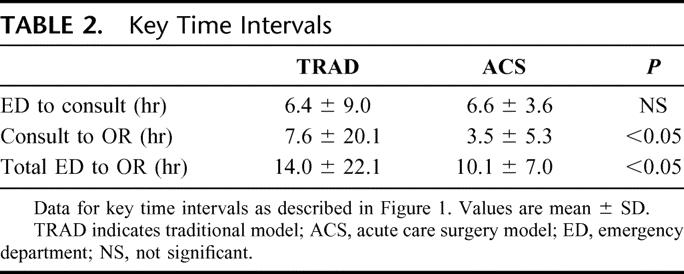
Surgical consultation occurred most frequently between 1600 and 2400 in both groups (Fig. 2). More than 30% of consultations in the ACS group occurred between 0000 and 0800. In contrast, more than 30% of consultations in the TRAD group occurred between 0800 and 1600. The timing of operative intervention is presented in Figure 3. More than 40% of surgeries in the TRAD group occurred between 1600 and 2400. In contrast, more than 40% of surgeries in the ACS group occurred between 0000 and 0800, compared with only 25% of surgeries in the TRAD group (P = 0.08). Of note, laparoscopic appendectomy was performed in only 10% of the ACS group and 6.5% of the TRAD group (P = not significant). One patient in each group required conversion to an open procedure.
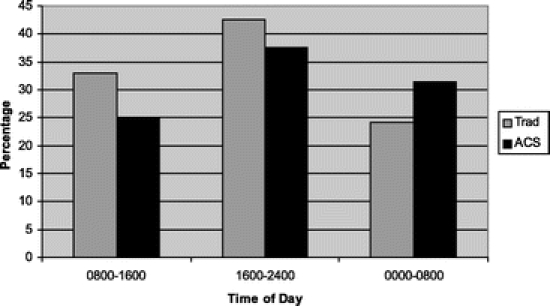
FIGURE 2. Timing of consults for in-house acute care surgeon model (ACS) and home-call traditional model (TRAD).
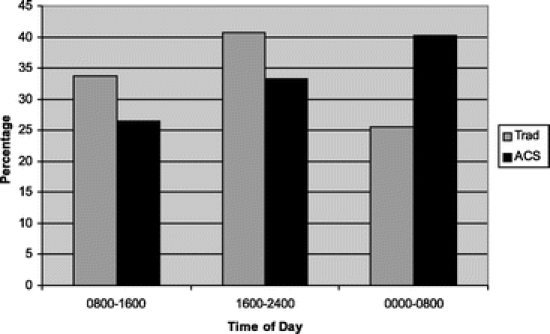
FIGURE 3. Timing of operations for in-house acute care surgeon model (ACS) and home-call traditional model (TRAD).
The years of experience of the attending surgeons are presented in Table 3. In the TRAD model, 70% of the operations were performed by surgeons with greater than 5 years experience. In contrast, nearly 70% of the operations performed in the ACS model were staffed by attending surgeons with less than 5 years experience.
TABLE 3. Experience of the Operating Surgeons
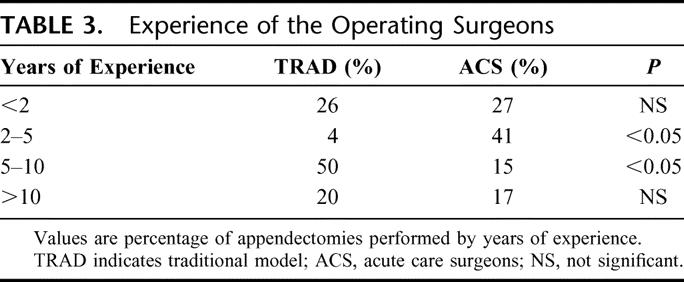
Outcome data are presented in Table 4. The rupture rate in the TRAD model was significantly increased compared with the ACS group. This includes 4 patients in the TRAD group (and none in the ACS group) who were treated with interval appendectomy for evidence of rupture and appendiceal abscess noted on initial computed tomography imaging. Negative appendectomy rates were similar between the 2 groups. The complication rate was significantly higher in the TRAD group. The most common complication was wound infection in both groups (TRAD 6.5% vs. ACS 3.6%, P = not significant). The incidence of intraabdominal abscess was higher in the TRAD model but did not reach statistical significance (TRAD 2.4% vs. ACS 0.6%, P = not significant). Hospital length of stay was significantly shorter in the ACS group.
TABLE 4. Outcome Data
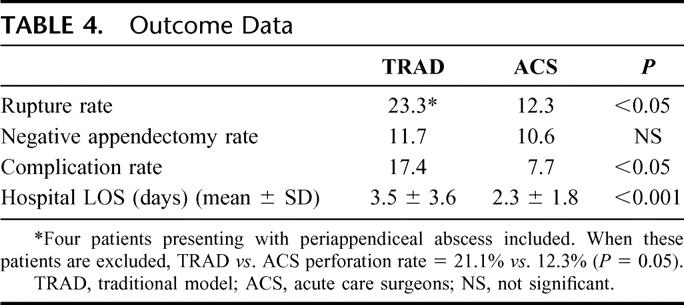
DISCUSSION
Caring for patients with surgical emergencies is one of the cornerstones of our profession. The potential to promptly diagnose an acute surgical problem and intervene in a timely fashion presents the surgeon with a unique opportunity to immediately impact a critically ill patient. As the population ages, the patients with surgical emergencies tend to have considerably more comorbid conditions and active medical problems. Unfortunately, these patients present at all hours of the day and night. They are challenging, time-consuming, and disruptive to the busy practicing surgeon. As a result, the surgeon's well-orchestrated and extremely efficient schedule of the day (outpatient office hours, elective surgical caseload, and for some, protected academic time) is often greatly disrupted by an emergent consultation. When emergent surgery is necessary, identifying available time in a busy OR schedule that does not further impact the surgeon's other responsibilities may be an additional challenge. Compounding this, many emergencies seem to occur on off hours and weekends, disrupting rest, family, and personal times. The possibility of being up all night or all weekend has both explicit and implicit effects on surgeons scheduling full clinical loads the following day. Finally, very little recognition or value can be currently found in academic surgical departments for taking on this difficult and complex patient population.10 Traditionally, the surgical trainee has played a major role in patient care during off hours. While the educational experience offered by this period of relative nonsupervision may be significant, the care rendered to those patients with surgical emergencies (arguably the ones who can least afford suboptimal or minimally supervised care) may be less than ideal. In many instances, faculty are only in phone contact with surgical trainees regarding emergent care of an acutely ill patient. Even at the academic medical center, the sickest emergency patient may not see a faculty surgeon for many hours during the crucial initial phases of emergency surgical care.
The acute care surgeon may be an answer to many of these and other issues prevalent in the current surgical setting. The backbone of such a program, the trauma and critical care surgeon, is already present at many medical centers. Seventy percent of level I trauma centers currently have 24/7 in-house faculty trauma surgeons.1 Because of the broad nature of injury, this specialty is already trained and familiar with a wide scope of surgical problems. In addition, more than 75% are trained and practice critical care so they have an expertise in the management of the comorbid conditions so often present in the emergent surgical patient. Expanding the trauma surgeon's role to a broader surgical emergency one has already begun to occur at a number of hospitals where emergency general surgery has been added to the responsibilities of the trauma surgeon. This new acute care surgeon can be at the bedside of the patient with a surgical emergency at a moment's notice. The experience that they bring to the bedside at all hours of the day and night should be beneficial to both the care of the ill surgical patient as well as the education of the surgical trainee.
As mentioned above, the ACS model has been described in the surgical literature by a number of academic institutions.3,6–9 Most of these reports focus on surgeon satisfaction, surgeon caseload and diversity, and surgeon productivity. To date, no emergency general surgery outcome data relevant to this frame shift are available. This study presents outcome data for one of the most common surgical emergencies, acute appendicitis, collected during a period when care of these patients transitioned from a TRAD model of home call faculty surgeon coverage to an in-house ACS model.
During the study period, patients treated in an ACS model realized a 50% decrease in the time interval between surgical consultation and operative intervention. This streamlined process to the operating room was associated with a decreased appendiceal rupture rate, fewer complications, and a shorter hospital length of stay. Negative appendectomy rates were similar between the groups.
The significant (>4 hour) decrease in time to operative intervention in the ACS group is noteworthy. More than 40% of appendectomies performed in the ACS group occurred between 0000 and 0800 (compared with only 25% in the TRAD group). Clearly, OR availability at these times was not an issue at a level I trauma center. Operating rooms were covered by perioperative staff 24 hours/day, with enough in-house and on-call depth to manage several emergency cases simultaneously. Surgeon availability is often the only potential delay at this time of the day. In contrast, while more operating rooms may be staffed from 0800 to 1600, emergent surgical cases must compete with elective cases for available OR time. The potential for delays during these peak elective times is often beyond the control of the surgeon and may lead to the add-on of a “routine” emergency to late in the day when the elective schedule is winding down. Delays to the operating room based on OR availability (vs. surgeon availability) were not specifically studied but may have affected the time to the operating room during the busier operative time periods of 0800–1600 and 1600–2400.
The presence of in-house surgeons may play another role in the significant difference noted in the time from surgical consultation to operative intervention. Delays in a faculty surgeon's examination of a patient and confirmation of the decision for surgery were likely minimal in the ACS model. Not surprisingly, preoperative attending documentation was much more likely to be present in the ACS model. Preoperative radiologic evaluation appeared not to be a factor in delays to surgical intervention. The percentage of patients undergoing computed tomography imaging as part of their evaluation was similar between groups. The presence of an in-house surgeon seems to be more important than the experience of the surgeon. In our study, the outcomes were better in the ACS model despite 70% of the operations being performed by surgeons with less than 5 years experience.
The percentage of patients found to have ruptured appendix was significantly greater in the TRAD model. Other outcome data regarding complication rates and hospital length of stay may be closely linked to this finding. The reasons behind the higher rupture rate may be multifactorial. Four patients were found to have appendiceal rupture and a periappendiceal abscess on initial presentation in the TRAD group. While the time to surgical intervention was not included in the analysis performed, these patients were used to calculate the rupture rate for the group. However, even when excluding these patients, the difference in rupture rates between groups is marked (TRAD 21.1% vs. ACS 12.3%, P = 0.05).
Patients in the TRAD group were significantly older than those in the ACS group. It is generally accepted that the diagnosis of acute appendicitis may be more difficult in older patients and, therefore, rupture rates may be increased. Conversely, the percentage of female patients was higher in the ACS group. Again, it is accepted that the differential diagnosis of right lower quadrant pain in the female patient is much broader than in the male patient. As a result, delays in diagnosis of appendicitis may be expected in this patient group.
The association of delays to the OR and rupture rates seems intuitive but is only partially supported in the literature. Although there are some reports of surgical delay contributing to complicated appendicitis,11,12 others have reported that patient delay in presentation is the only significant factor determining the incidence of complicated appendicitis.13,14 Based on these reports in the literature, some authors have questioned, “Do we need to operate during the night?” for appendicitis.15 In a retrospective review of 126 children presenting to the University of Michigan between 1998 and 2001, the surgeons eliminated operations between the hours of 2000 and 0800, choosing instead to admit all patients presenting during that time and treat them initially with antibiotics. They concluded that delaying surgery until the daytime hours did not significantly affect operating time, perforation rate, or complications. However, hospital cost and length of stay were increased in those patients. In contrast, another recent study in adults (average age, 29 years) reported an increasing risk of rupture with both delays in presentation and treatment. In a retrospective review of 219 patients with acute appendicitis, they reported a very low risk of rupture with delays in treatment up to 36 hours after symptom onset. The risk of perforation rose 5% for each ensuing 12-hour period with untreated symptoms.16 Thus, the delay of 14 hours from presentation to the OR observed in the TRAD model in this study, in itself, may account for up to a 5% increase in the perforation rate. Of interest, the TRAD model perforation rate was in range with published national rupture rates (20%–30% over the last 70 years).17 The ACS model outperformed most reported rupture rates and was significantly lower than that recently reported in the adult study cited above.16
In the current national environment focusing on quality, safety, and outcomes, it is unlikely that increased hospital costs and length of stay would be tolerated. In addition, many hospital operating room schedules often run at peak and maximal efficiency, and their managers are especially motivated to assure minimal disruption of start and block times. Delaying operative cases until the morning or afternoon hours, and disrupting the elective schedule and outpatient office hours, seems a poor alternative to providing prompt surgical intervention to those who need it.
Our study has several limitations. It is a single institution study performed retrospectively, and with a modest number of patients. We did not collect information on time from onset of symptoms to presentation, which may have strengthened our analysis on perforation and complication rates. The age difference between the groups, although difficult to explain, may account for the higher perforation rates on presentation. However, the time interval from surgical consultation to operative intervention is significantly longer in the TRAD model. In addition, the time of day for the performance of operation is different between the 2 models, with ACS more likely to operate during the night. These factors may explain the improved outcomes (rupture rate, complication rate, and hospital length of stay) seen in the ACS model. This study compares models of care provision. It does not compare, nor should it be interpreted as comparing, individual surgeon performance. Indeed, comparing the TRAD model to several recent large outcome studies of patients with appendicitis, the TRAD model performance indicators were similar to these benchmarks. However, the ACS model outperformed and appears to have better outcomes than these previous studies (Table 5).
TABLE 5. Comparison With Previous Studies
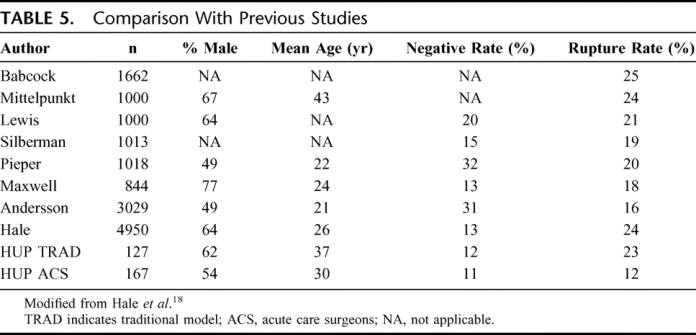
CONCLUSION
In patients with acute appendicitis, the presence of an in-house Acute Care Surgeon significantly decreased the time to operation, length of stay, complication rate, and rupture rate, without a difference in the negative appendectomy rate. The ACS model appears to improve outcomes of acute appendicitis compared with a traditional home-call model. This study supports the efficacy, as well as efficiency, of the ACS model in management of surgical emergencies.
Discussions
Dr. Mark A. Malangoni (Cleveland, Ohio): Dr. Schwab, I certainly enjoyed your presentation and enjoyed reading the paper as well. This morning President Pellegrini alluded to the evolution of acute care surgery as a new surgical subspecialty, and you have presented high quality data that this model works in the care of a common surgical disease, acute appendicitis. The 4-hour reduction in time from the consultation to the operating room translates to a 47% risk reduction in rupture and a 56% risk reduction in complications as well as a one-day-shorter hospital stay, improvements that are hard to argue with.
If I was an acute care surgeon contemplating the importance of this new subspecialty, I would say these data unquestionably support the development of this new discipline. As a general surgeon, I would look at the data differently and I would conclude that it confirms that the existing information that reducing the delay from the time of diagnosis to the operating room in adults results in better outcomes, a fact that has been certainly supported by many previous studies as well as your current study. This strongly suggests that it is quality patient care, not surgeon convenience, that must take precedence.
I have a couple of questions for you. You have already addressed the issue of patient presentation at the emergency department and its potential impact. My 2 questions are: The acute care surgeons seem to get a greater number of consults between midnight and 8:00 am. Do you think the fact that the emergency medicine physicians knew that there was an in-house attending surgeon that would respond to consultation resulted in a propensity for them to call you and hence may have decreased the time to consultation for the acute care surgeon and may have affected the results?
Second, we all know that this acute care surgery model is still controversial, particularly in nonteaching hospitals, where there are fewer surgical subspecialists. Now, if you believe that all hospitals should have acute care surgeons, could you expand a bit upon how that would occur? If you feel that this is a model that only should apply to those of us who work in teaching hospitals where there may be a greater number of surgical subspecialists, what should be done in the community hospitals where there is less likely to be a trained acute care surgeon present?
Dr. C. William Schwab (Philadelphia, Pennsylvania): First of all, I don't know if the Yogi Berra element was in work here. And that is, you know, showing up is 89% of the game. I just don't know if that was true.
I will tell you that the way the emergency physicians consulted the surgical service did not change whether it was a month in which the acute care surgery model was in place or the traditional model was in place. The consults came to a third-year surgical resident, he responded, sought consultation if necessary from a more senior surgical resident and at that point we were brought in, meaning the faculty. The fact that we were there, I just can't say. And as I said but didn't explain it, I wish this was a time-in-motion study in which I could provide you all hour to hour what was going on in the management of these cases. I can't. And this is really looking at that from really, I think, 37,000 feet.
The next question you asked is, do I think this is a model that works only in a teaching hospital? For me to speculate on that is looking into a crystal ball. I will tell you that I have 2 colleagues that are in trauma critical care, both of whom have been recruited from academic surgery into the community practice and specifically hired by hospitals with the consent, approval and support of the departments of surgeries in these community hospitals to establish an acute care surgical model to relieve them of all the burden of the ED and the trauma patients.
It is an interesting observation. I personally do not think that this model is only for the academic medical centers or teaching hospitals. I think it is applicable to any particular hospital. I also don't think it is applicable only for surgeons that have special training in critical care and experience in trauma. I think any general surgeon broadly based and well trained with an interest can be an acute care surgeon. I think we ought to design to train the future generations with the curriculum that the AAST is developing, but we need to stay tuned for what that looks like.
Dr. Christopher C. Baker (Boston, Massachusetts): Dr. Schwab, another great study following on the heels of the paper you presented 2 years ago in Washington. I have 2 questions. What were the rates of laparoscopic versus open appendectomy in the 2 groups and do you think that had anything to do with the shorter length of stay in the ACS group? The second question, despite what Dr. Malangoni said, I wonder how you explain the 2-fold increase in incidence perforation in the traditional model given that it was only a 4-hour delay and even at that was to the OR in 13 hours.
Dr. C. William Schwab (Philadelphia, Pennsylvania): First of all, let me just say that the rates of laparoscopy and laparoscopic over the appendix were very low across the 3-year time frame. For the acute care surgical model it was 10% and in the traditional model it was 6.5%. So we don't think it has any effect on length of stay.
Your second question–We go into it a little bit in the manuscript about the confounding variables that are in this patient population. Let me just say that I can't explain it. It is interesting. A recent paper by Nina Bickell, her second, looking at appendicitis and the natural history, says that for every 12 hours of delay from the onset of presentation, the perforation rate increases 5%. And I don't know if that is in play here or not, but I think that the longer you wait, the more perforations you will see.
Dr. John G. Hunter (Portland, Oregon): Dr. Schwab, a very nice paper. This morning we learned that older surgeons can do it just as well. But I think you have shown us that older surgeons, except for yourself, take longer to get the patients in the operating room.
But all kidding aside, I think that Dr. Baker asked my question to a certain extent about laparoscopy, but your answer suggested that it is still being used in a fairly small proportion of cases. Have you seen over the years that increasing, and what is your general philosophy in the acute care surgical setting towards laparoscopic procedures, laparoscopic appendectomy particularly?
Dr. C. William Schwab (Philadelphia, Pennsylvania): First and foremost, if you remember, the time frame of this study and the transitional period occurred in roughly 3 years, late 1999 to 2002, and it may be different now. I don't think so. I would say it is probably a little bit more. I think we do it more frequently. I think the younger members of our group are much more facile with it.
I will tell you that one of the things that is very interesting is the logistics that you are doing. In a previous paper that we did on the acute care surgical model and its effect on the trauma patient, we found that the acute care surgeon is working much harder with very little down time between cases, whether they be emergency department evaluations, trauma resuscitations or operations. And I think that logistics may be in play currently at our institution to keep laparoscopic use somewhat limited.
Dr. Kenneth G. Swan (South Orange, New Jersey): Dr. Schwab, my compliments to you as usual. I sense amongst medical students and junior residents a disinterest in trauma as a specialty because they do less surgery than their counterparts in other fields. They tend to wet nurse the neurosurgeons and the orthopedic surgeons, they do “blue plate specials,” tracheostomies, gastrostomies and Greenfield filters. Does this, in your opinion, open up a new horizon for recruitment of our best people back into trauma surgery?
Dr. C. William Schwab (Philadelphia, Pennsylvania): Well, Dr. Swan, I am going to come down and give you a $100 bill. Thank you very much for asking that. The answer is yes. And really the committee that has been working very hard at the AST headed by Dr. Jerry Jurkovich, who is here today, for the last 3 years has really focused on that question. To be blunt, we don't know. To be optimistic, we hope so, we really hope so.
Dr. Ronald V. Maier (Seattle, Washington): Dr. Schwab, as you pointed out, there was only one surgeon that was still willing to be doing appendectomies at 2:00 am, after the age of 40. With 70% of the procedures done by people less than 5 years out of their training, how long will they stay interested in doing procedures such as appendectomies at 2:00 am; and who is going to do them after they turn 40? Not the patients, the surgeons.
Dr. C. William Schwab (Philadelphia, Pennsylvania): These are all good questions in looking at the surgical workforce. Let me say that we just presented to you appendicitis and appendectomy. A previous study actually looked at the effect of the acute care surgeon and moving the trauma and critical care surgeon to cover all surgical emergencies. And not only did the caseload increase but the diversity and complexity of the cases asked of those surgeons to take care of increased tremendously.
About 50% of our cases are surgical, abdominal emergencies and disasters. The other 50% of our acute care surgical cases are things like appy's, cholecystitis, hernias, etc. So I think the diversity of the cases and the critical nature of the cases makes it very interesting and challenging.
And I can't answer your questions about what you are going to be doing in a few years.
Footnotes
Reprints: John Pryor, MD, Division of Traumatology and Surgical Critical Care, University of Pennsylvania School of Medicine, 3440 Market St., Philadelphia, PA 19104. E-mail: pryorj@uphs.upenn.edu.
REFERENCES
- 1.Esposito TJ, Leon L, Jurkovich GJ. The shape of things to come: results from a national survey of trauma surgeons on issues concerning their future. J Trauma. 2006;60:8–16. [DOI] [PubMed] [Google Scholar]
- 2.Spain DA, Miller FB. Education and training of the future trauma surgeon in acute care surgery: trauma, critical care, and emergency surgery. Am J Surg. 2005;190:212–217. [DOI] [PubMed] [Google Scholar]
- 3.Kim PK, Dabrowski GP, Reilly PM, et al. Redefining the future of trauma surgery as a comprehensive trauma and emergency general surgery service. J Am Coll Surg. 2004;199:96–101. [DOI] [PubMed] [Google Scholar]
- 4.Asplin BR, Magid DJ, Rhodes KV, et al. A conceptual model of emergency department crowding. Ann Emerg Med. 2003;42:173–180. [DOI] [PubMed] [Google Scholar]
- 5.Derlet RW, Richards JR. Overcrowding in the nation's emergency departments: complex causes and disturbing effects. Ann Emerg Med. 2000;35:63–68. [DOI] [PubMed] [Google Scholar]
- 6.Lewin Group. Emergency Department Overload: A Growing Crisis. The Results of the AHA Survey of Emergency Department (ED) and Hospital Capacity. Available at: http://www.hospitalconnect.com/aha/press_room-info/content/EdoCrisisSlides.pdf. Accessed Online May 5, 2006.
- 7.Scherer LA, Battistella FD. Trauma and emergency surgery: an evolutionary direction for trauma surgeons. J Trauma. 2004;56:7–12. [DOI] [PubMed] [Google Scholar]
- 8.Ciesla DJ, Moore EE, Moore JB, et al. The academic trauma center is a model for the future trauma and acute care surgeon. J Trauma. 2005;58:657–661 ;discussion 661–662. [DOI] [PubMed]
- 9.Austin MT, Diaz JJ Jr, Feurer ID, et al. Creating an emergency general surgery service enhances the productivity of trauma surgeons, general surgeons and the hospital. J Trauma. 2005;58:906–910. [DOI] [PubMed] [Google Scholar]
- 10.Kaplan LJ, Frankel HL, Hojman H, et al. What price for general surgery? J Trauma. 2005;59:391–394; discussion 394–395. [DOI] [PubMed]
- 11.Reilly PM, Schwab CW. Acute care surgery: the academic hospital's perspective. Surgery. In press. [DOI] [PubMed]
- 12.Buchman TG, Zuidema GD. Reasons for delay of the diagnosis of acute appendicitis. Surg Gynecol Obstet. 1984;158:260–266. [PubMed] [Google Scholar]
- 13.Lewis FR, Holcroft JW, Boey J, et al. Appendicitis: a critical review of diagnosis and treatment in 1,000 cases. Arch Surg. 1975;110:677–684. [DOI] [PubMed] [Google Scholar]
- 14.Eldar S, Nash E, Sabo E, et al. Delay of surgery in acute appendicitis. Am J Surg. 1997;173:194–198. [DOI] [PubMed] [Google Scholar]
- 15.Pittman-Waller VA, Myers JG, Stewart RM, et al. Appendicitis: why so complicated? Analysis of 5755 consecutive appendectomies. Am Surg. 2000;66:548–554. [PubMed] [Google Scholar]
- 16.Yardeni D, Hirschl RB, Drongowski RA, et al. Delayed versus immediate surgery in acute appendicitis: do we need to operate during the night? J Pediatr Surg. 2004;39:464–469 ;discussion 464–469. [DOI] [PubMed]
- 17.Bickell NA, Aufses AH Jr, Rojas M, et al. How time affects the risk of rupture in appendicitis. J Am Coll Surg. 2006;202:401–406. [DOI] [PubMed] [Google Scholar]
- 18.Hale DA, Molloy M, Pearl RH, et al. Appendectomy: a contemporary appraisal. Ann Surg. 1997;225:252–261. [DOI] [PMC free article] [PubMed] [Google Scholar]


